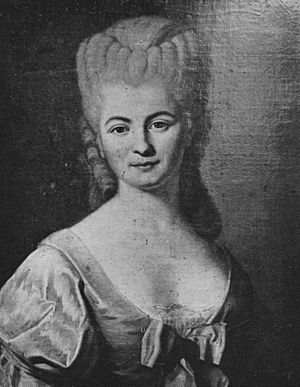Nicole-Reine Lepaute facts for kids
Nicole-Reine Lepaute (née Étable de la Briere; also known as Hartense Lepaute or Hortense Lepaute; 5 January 1723 – 6 December 1788) was a French astronomer and mathematician. Lepaute along with Alexis Clairaut and Joseph Lalande predicted the return of Halley's Comet by calculating the timing of a solar eclipse and constructing a group of catalogs for the stars.
The asteroid 7720 Lepaute is named in her honour, as is the lunar crater Lepaute. She was also a member of the Scientific Academy of Béziers.
Contents
Biography
Nicole-Reine Lepaute was born on 5 January 1723 in the Luxembourg Palace in Paris as the daughter of Jean Étable, valet in the service of Louise Élisabeth d'Orléans. Her father had worked for the royal family for a long time, both in the service of the duchess de Berry and her sister Louise. She was the sixth of nine children. As a child she was described as precocious and intelligent, being mostly self-taught. She stayed up all night "devouring" books and read every book in the library, with Jerome Lalande saying of her once that even as a child "she had too much spirit not to be curious". In August 1749, she married Jean-André Lepaute, who was a royal clockmaker in the Luxembourg Palace. He quickly became famous all over Europe for his exceptional work.
Early career
Nicole Lepaute constructed a clock with an astronomical function together with her spouse. The clock was constructed on her suggestion, and she also participated in its construction. The clock was presented to the French Academy of Science in 1753, where it was inspected and approved by Jérôme Lalande.
After completing the clock with her husband, she worked with both him and Lalande on a book titled "Traite d'horlogerie (Treatise of Clockmaking) that was published in 1775 under her husband's name. Though she did not receive authorship, Lalande sang her praises later, saying, "Madame Lepaute computed for this book a table of numbers of oscillations for pendulums of different lengths, or the lengths for each given number of vibrations, from that of 18 lignes, that does 18000 vibrations per hour, up to that of 3000 leagues."
Halley's Comet
Jérôme Lalande recommended her along with the mathematician Alexis Clairaut to calculate the predicted return of Halley's Comet, as well as to calculate the attraction of Jupiter and Saturn of the Halley's comet. The team worked on the calculations for more than six months straight, barely stopping for food. In November 1758, the team presented their conclusion that the comet would arrive on 13 April 1759. They were almost correct, as the comet arrived on 13 March 1759. As a result of their calculations, this was the first time scientists had successfully predicted when the comet would cross the perihelion, i.e. the point of the comet orbit closest to the Sun. Clairault did not recognize her work at all in his work, which upset Lalande who considered Lepaute the "most distinguished female French astronomer ever." Jérôme Lalande acknowledged her help in an article.
Later mathematical accomplishments
In 1759, she was again a part of Lalande's team and worked with him to calculate the ephemeris of the transit of Venus. What should be attributed to her personally is not documented, but in 1761 she was acknowledged by being inducted as an honorary member of the distinguished Scientific Academy of Béziers. Lalande also collaborated with Lepaute for fifteen years on the Academy of Science's annual guides for astronomers and navigators by developing ephemerides: tables that predict the location of the stars on each day of the year, and after her death, wrote a brief biography about her contributions to astronomy.
In 1762, Lepaute calculated the exact time of a solar eclipse that occurred on 1 April 1764. She wrote an article in which she gave a map of the eclipse's extent in 15-minute intervals across Europe and predicted the time and percentage each are in Europe would experience. The article was published in Connaissance des Temps (Knowledge of the times). She also created a group of catalogs of the stars which were useful for the future of astronomy. She calculated the ephemeris of the Sun, the Moon and the planets for the years 1774–1784.
Personal life
While childless herself, she adopted her husband's nephew, Joseph Lepaute Dagelet, a future member of the French Academy of Science, in 1768. She trained him in astronomy and advanced mathematics so well that he became a math professor at the French Military School at age 26 before being elected deputy astronomer eight years later in 1785 at the French Royal Academy of Sciences. Nicole Lepaute took care of her terminally ill husband from 1767 until her death in Paris on 6 December 1788. She had gone blind herself just a few short months before.
See also
 In Spanish: Nicole-Reine Lepaute para niños
In Spanish: Nicole-Reine Lepaute para niños


